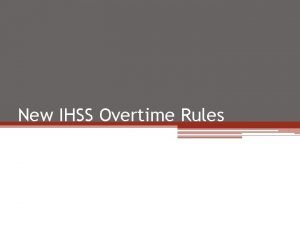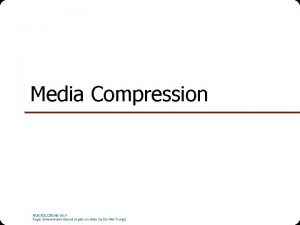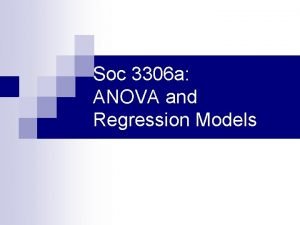Soc 3306 a Individual Assignment 6 Introduction For












- Slides: 12

Soc 3306 a Individual Assignment 6

Introduction • For Assignment 6 you will use the causal model that you created for the Problem Statement assignment (Sept. 27), complete with any revisions that were suggested by me or the TA. • Assignment 6 takes you through the process of testing your model and then making further revisions as necessary. • The completed causal model will become the main analysis for your research report, although you may wish to include additional statistical tests (T-tests, One or Two-way Anova, etc. ) in order to fully analyze your research problem.

Index • If you have decided to incorporate an index as one of your main variables, start by creating it now. • To do this, find a series of related variables with the same answer categories and follow the techniques in Szafran Ch. 5 (SPSS 1) • Test index for reliability. • Save your indexed variable(s) in working data file. • Note: Your DV should be at the interval-ratio level, and if it is not, you can create the index for your DV. If desired, you can create more than one index for your analysis but if you are using ordinal variables with > five categories, you can use them "as is. "

Frequencies and Histograms • Run frequencies and histograms (Analyze>Descriptives>Frequencies), asking for a normal curve and skewness/kurtosis statistics for all intervalratio, summated ordinal indexes and ordinal variables. • You do not need to print any of this output – just examine it and save the file in order to answer #8 on Assignment 6.

Bivariate Correlation Matrix • Create a bivariate correlation matrix (see Ch. 9 p. 218 -22) incorporating your variables, listing your DV first. (Don't worry if not all your variables are at the intervalratio level, because you are merely checking to see if your proposed relationships between your DV and other variables are 'real'. ) Go to Analyze > Correlations and use "exclude cases listwise" (p. 221)

Revising Your Model • Drop any variables that are not significantly correlated with your DV unless you have theoretical reasons for keeping them in the model. • If there are indications of multicollinearity in the IV's (r-values >. 6) drop one of the two variables that are highly correlated or choose a different variable (again see text, p. 248 -9). • Run a revised correlation matrix and check for changes.

Revised Causal Model • Redraw your causal model, incorporating above revisions and indicating all relationships you now expect to find. • You will use this revised diagram for the regression analysis and path analysis in Part II of Assignment 6.

Regression Preparation • Create scatterplots for your DV with all IV's at the interval ratio, ordinal or summated ordinal level (i. e. your index. ) • If any of your IV's are at the nominal level, you will now need to recode them into binary "dummy" variables to use in the analysis (Szafran Ch. 10) • Run and save frequency tables for dummy variables. Check to make sure that the number of cases are consistent with the original frequencies. • Save this output and don’t forget to save your dummy variables as part of your working data file!

Multiple Regression Analysis • Go to Analyze>Regression. Method=Enter. • Under Statistics, check off Estimates, Model Fit, Descriptives, and Partial Correlations. • Under Options, the default Listwise should be checked off. • Add your variables on at a time. – In Block 1, enter your main IV. Under Statistics, ask for R 2 change. – Click next, and enter an additional IV. – Repeat until all variables have been entered.

Partial Regression Models • This step is necessary to do a complete causal path analysis. • You need to calculate the Beta values for all of the other causal relationships in your model. • Use Analyze>Regression, Enter and Listwise to create partial models. You do not need to enter the variables using the Block method – simply enter each partial model as is.

Partial Models (cont. ) • You will need to run a partial regression analysis for each endogenous IV in your model. Endogenous IV’s are those that have prior causes as indicated in your revised model. • Exogenous variables (those that have no prior causes in your model) can be ignored.

Saving and Printing Output • Save all of your changes and output for this assignment. • Print only the output and syntax for the Multiple Regression Analysis and for the Partial Regression Models. • The printed output and your syntax will be submitted as an appendix to Assignment 6, along with your completed causal path analysis.






















